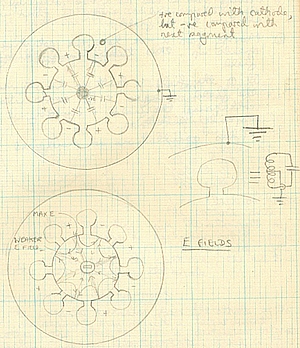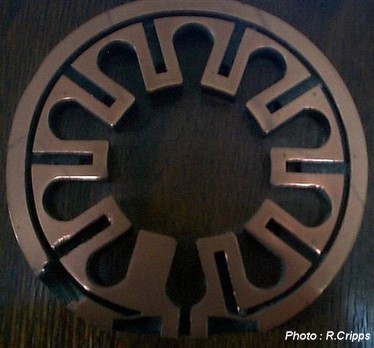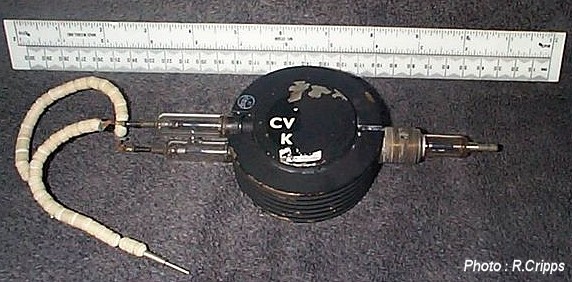


|

|
The device that is said to have changed the outcome of the Second World War surely deserves at least a brief mention especially as there is a tenuous RAF Ventnor connection : it is known that in the summer of 1939 Randall & Booth visited the site, staying for several weeks for familiarisation with the current equipment and presumably to experience the practicalities and shortcomings of that current 'long' wave equipment. An acquaintance of the author, Tom Berg, recalls two men who were staying "just before the war" at his mother's boarding house in Ventnor,"Sea Vista" in Upper Gills Cliff Road, talking excitedly about "intense magnetism". Could they have been the two scientists? I shall assume that they were until advised otherwise.
Development of radar systems for airborne use and to some extent that used at sea was hampered by the lack of a device producing high power radio frequency energy of very short wavelengths. A shorter wavelength allowed a more compact aerial system to be used and a narrower beam could be produced, giving more accurate resolution at all ranges. Staff at Birmingham University had been tasked by the Government to develop a high powered microwave transmitting device and they were aware fully of the magnetron invented in the USA in valve form in the nineteen twenties and that it could only develop a few tens of watts of power. They strove to make improvements and in 1940 Randall & Boot created the Cavity Magnetron.
The earlier primitive magnetron consisted of an evacuated glass envelope containing a thin vertical cathode surrounded by four anode segments connected to external resonating circuits. When a high voltage was applied to the anodes, the large magnetic field from the coil of an electromagnet surrounding the envelope caused electrons emitted from the hot cathode to spin in circles across the surfaces of the anodes, exciting oscillations in the external resonating circuits.
Many people will be familiar with the normal method used for tuning a radio receiver i.e. a tuning coil connected in parallel with a variable capacitor. To tune shorter wavelengths the capacitor knob must be turned to give reduced capacity. To go still lower, some turns on the coil must be removed. At some very high frequency point, just one turn will suffice and no capacitor at all is needed as a tiny capacitance exists between the ends of the coil. Now suppose the wire of the coil was replaced by a strip of copper e.g. perhaps 2mm thick and 3cms or so deep and formed into a loop a couple of centimetres in diameter. This would still work well as a tuned circuit. Next imagine the thickness of the copper to be greatly increased : you'd still have a tuned circuit but it would look like a very thick miniature horseshoe. If it was 5cms thick it wouldn't look at all like a 'coil', more like a two centimetre hole bored in a round copper block with a slot cut from the outside into the hole. 'Tuning Coil' would no longer be an apt description, but 'resonant cavity' might suit, because if you blew across the slot, the thing might produce an audible note. Likewise, if pulses of electrons were made to rush across the slot, microwave oscillations would be generated within the cavity at a frequency determined principally by the diameter of the cavity.
This is the path Randall & Boot followed, partly because they had read that Hertz, the discoverer of wireless waves, had himself considered the single loop of copper wire as a tuned circuit. However it dawned upon them that the thickness of the copper was more or less immaterial to the frequency, so could be increased to whatever extent necessary to dissipate the considerable heat inevitably associated with high power. An already existing low power microwave device, the klystron, used tuned cavities, and Randall & Booth combined the three ideas of the magnetron principle, the klystron's cavities and thick copper to create their brainchild. The manufacture of the device from a solid block of copper is what made their version different from all others. However their first model was water cooled, used a huge elecromagnet and the device needed to be connected permanently to a vacuum pump, so was hardly a practical proposition. GEC solved these problems and Sayers also at Birmingham University mostly solved a new problem of frequency instability.
 The production model manufactured by GEC and BTH consisted of a cylindrical copper block with no less than nine holes bored through it and this diagram from my Locking notebook gives some idea of the arrangement in the CV76 eight resonant cavity version. The thin section on the right however is from a later ten cavity design and the cavities have for whatever reason evolved from being the theoretically correct perfect cylinders.
The production model manufactured by GEC and BTH consisted of a cylindrical copper block with no less than nine holes bored through it and this diagram from my Locking notebook gives some idea of the arrangement in the CV76 eight resonant cavity version. The thin section on the right however is from a later ten cavity design and the cavities have for whatever reason evolved from being the theoretically correct perfect cylinders.
The larger hole through the axis contained the cylindrical cathode and within that, a heater wire. Surrounding this central hole are the ten resonant cavity holes of about a centimetre and a half diameter, each with a slot through to the central hole. Each flat end-surface of the copper cylinder was sealed with a plate of glass, and the air was extracted. Next, a hugely powerful permanent horseshoe magnet was arranged so that each of its poles abutted, but not fixed to, one of the glass surfaces. The cathode was made with a coating of material which when heated would liberate an abundance of electrons. In this state, when the copper had a high positive voltage pulse applied to it, the electrons emitted from the cathode were attracted towards the copper, but before they could reach it, the intense field from the magnet forced them to adopt a circular route, sweeping like the spokes of a wheel across the mouths of the slots of and stimulating the eight resonant cavities. Oscillations of increasing intensity were induced in all the cavities as the electrons gave up their energy during repeated circuits. Finally enfeebled, the electrons eventually fell back to the cathode, but were in such quantity that their return amounted to a bombardment and this further heated the cathode, liberating fresh electrons to such an extent that the heater current was no longer necessary and could be switched off. When the pulse of voltage applied to the anode (the copper block) ceased, the oscillations stopped immediately.
The means of harnessing this RF energy was simply arranged. During production, a hole had been drilled from the exterior through to one of the cavities. An insulated single loop of wire was inserted and the hole sealed. The other end of the wire terminated in a small sphere, and this was in the centre of a waveguide, which eventually reached the aerial. We will not go into the design of waveguide except to say that it is a highly engineered brass tube of either rectangular or circular cross section, the dimensions of which are determined by the frequency of the RF it is to convey. Two final points : the 32000 volt modulation pulse was actually of negative polarity and applied to the cathode. This removed problems of insulating the copper block, a huge advantage as the device needed to be cooled. By being at earth potential it was easily mounted to the framework and as the outside of the block had cooling fins machined into it, forced air cooling (or sometimes even watercooling) could easily be applied.

Well, now you have some idea of what is going on in that box in the corner of your kitchen, the microwave oven. Of course I apologise to any qualified RF engineers who may be doubled up with laughter after reading this account, but is there not merit in explaining complicated things in the simplest terms possible, to give an initial picture, rather than baffle with mind numbing science and mathematics from the outset? I also rather like the thought that the war was shortened by the inspired use of a lump of holy copper!
The Ventnor Connection :
My source of this interesting information about Randall & Booth's visit to Ventnor is :- "The Invention that Changed the World" by Robert Buderi. ISBN 0-349-11068-9 which tells in great detail the story of the development of radar from the American perspective. However ample due justice is given to the British early efforts. Almost as soon as it was created one of the prototype cavity magnetrons was taken to the USA together with a plea for help in developing an anti-U boat device. A well funded civilian Development Corporation, consisting of scientists and industrialists, entirely separate from the Military was already in existence working on radar but progress was hampered by the lack of a high powered microwave transmitting device. The Radiation Laborotory at the MIT seized on the British creation and never looked back. Despite untold bickering with the more conservatively minded armed forces, who resisted novel means of waging war, the civilians eventually prevailed when they produced a series of effective 3cm radars at about the time of Pearl Harbour.
Finally, I just couldn't resist adding this little ditty as it is so wonderfully refreshing to find that an enigmatic old relic in the Science Museum is capable of inspiring such an outpouring from modern youth in this newish art form. Found in the annals of The British Society for the History of Science it is part of an outreach project using museum objects from the history of science, technology and medicine. It is published here in the belief that there is conformity with the Society's copyright statement.
I am a cavity magnetron
Livin' in southerly Kensington
As I helped get that Second World War won
I'm an historic artefact, so hear me everyone.
My game is radar, so when I get humming
Those bouncing rays shout "missiles incoming!"
I weren't the first to go radar gunning,
But daddy "Chain Home" weighed a ton and something!
Made in Birmingham by Randall and Boot
Looked so cute.
My waves were short, with lots of power to boot
All in a box no more than a foot.
Now I'm so light I can travel in a plane
And submarines in a naval campaign:
Detecting enemies in the fast lane,
I became the enemy's pain and bane,
Once we'd given those dark powers a stuffing
War was over and the peace pipe was puffing.
Now my kids work in microwave ovens
Heating ready-cooked meals that you'all are lovin'
I am a cavity magnetron
Livin' in southerly Kensington
As I helped get that Second World War won
I'm an historic artefact, and that's a lot of fun!
As told by Graeme Gooday, March 2007
Source
Text © 2006 D.C.Adams
Photographs © 2006 R.Cripps
Rev030912